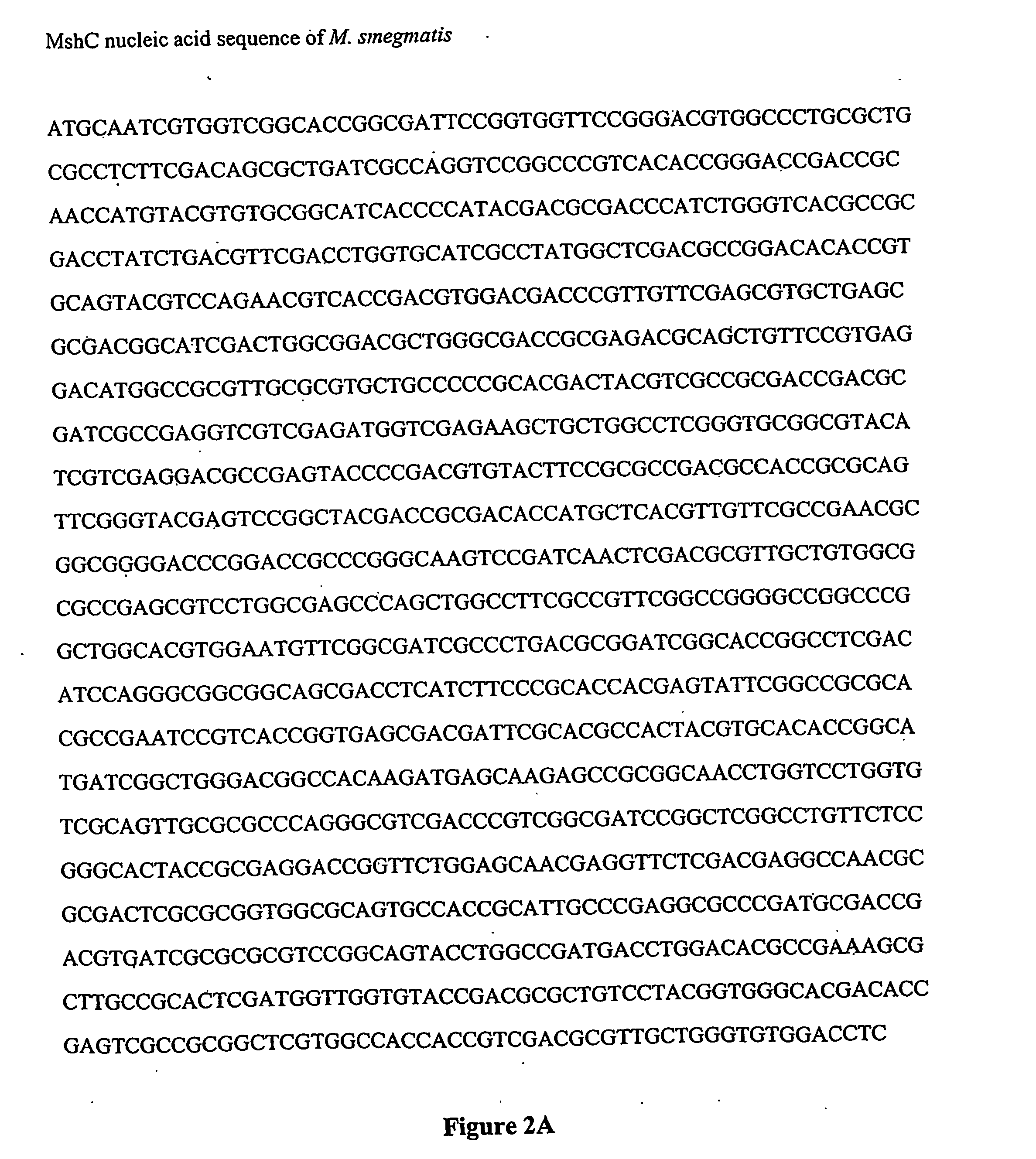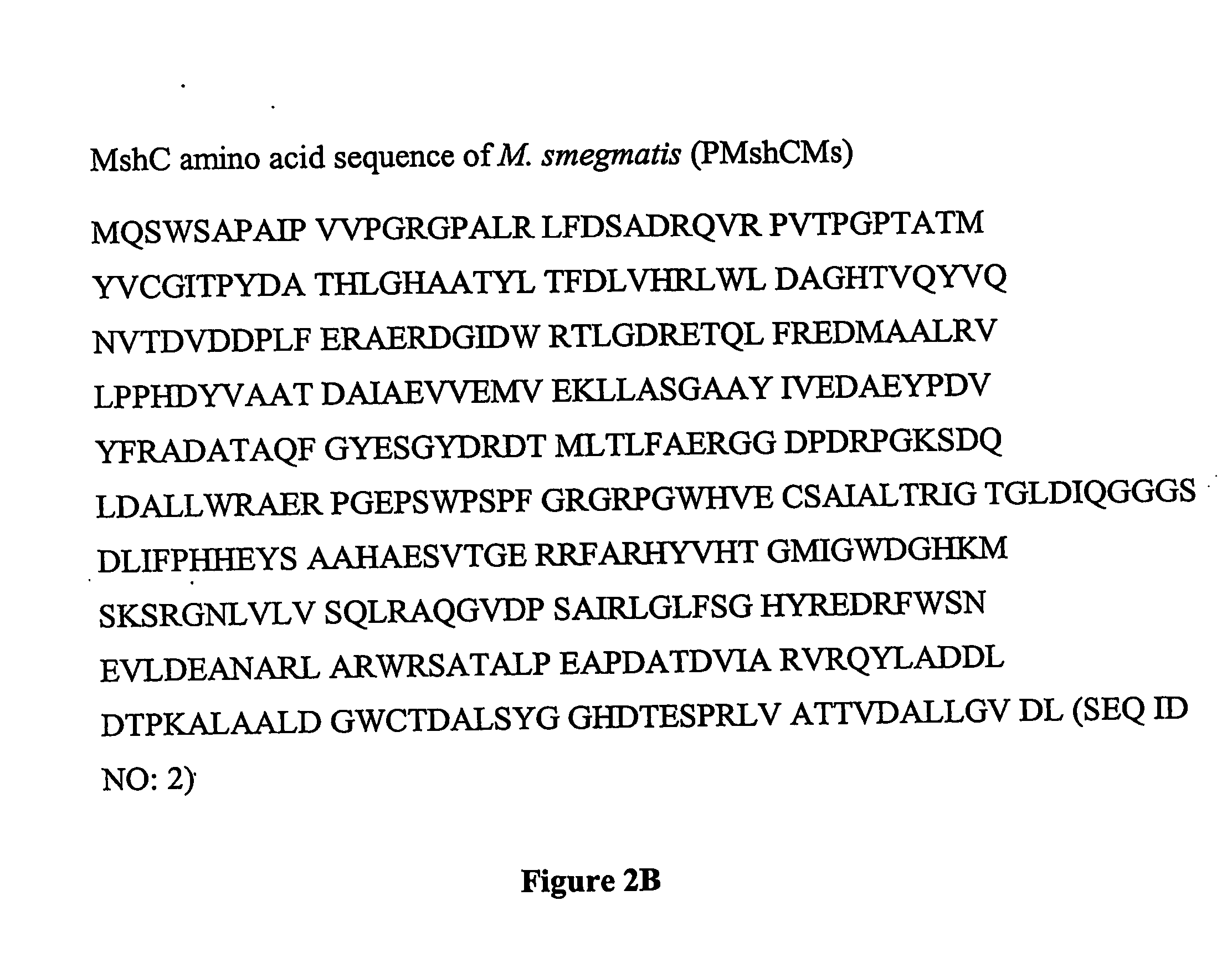Methods of use of the enzymes of mycothiol synthesis
- Summary
- Abstract
- Description
- Claims
- Application Information
AI Technical Summary
Benefits of technology
Problems solved by technology
Method used
Image
Examples
example 1
Identification of MshC
[0197] Bacterial culture. M. smegmatis strain mc2155 was grown in Middlebrook 7H9 broth (Difco Laboratories) supplemented with 0.05% TWEEN™ 80 (Fisher) and 0.4% glucose (Fisher) at 37° C. and 250 rpm. After 28 h of cultivation, the bacterial cells were collected by centrifugation at 8000 g for 15 min. The cell pellets were stored at −70° C. until used.
[0198] Reagents. MSH was isolated from M. smegmatis and derivatized with monobromobimane (mBBr, Molecular probes) to form the monobromobimane derivative of mycothiol (MSmB) and purified as described earlier (G. L. Newton et al. (1993) J. Bacteriol. 175, 2734-2742). GlcN-Ins was prepared by hydrolyzing MSmB quantitatively, with purified M. smegmatis mycothiol S-conjugate amidase, as previously described (G. L. Newton et al. (2000) Biochemistry 35, 10739-10746). CySmB-GlcN-Ins was purified by preparative high performance liquid chromatography (HPLC), after acid hydrolysis of MSmB, as described earlier (S. Anderber...
example 2
[0199] Assays. A minor modification of the protocol described by Anderberg et al (supra) was used for routine measurement of ATP-dependent ligase activity. The enzyme activity was assayed in a final volume of 25 μL containing 12.5 μL of the ligase in different dilutions, 50 μM GlcN-Ins, 100 μM Cys (Calbiochem), 1 mM ATP (Sigma), 1 mM MgCl2 (Fisher), 1 mM DTT (Calbiochem), 25 mM N-2-hydroxyethylpiperazine-N′-2-ethanesulfonic acid (HEPES) (Sigma), pH 7.5, and 35 μM each of the protease inhibitors (Sigma) N-α-p-tosyl-L-phenylalanylchloromethyl ketone and N-α-p-tosyl-L-lysinechloromethyl ketone. The mixture was incubated at 37° C. for 30 min. The assay was terminated by addition of 25 μL of 8 mM mBBr in acetonitrile and heating the mixture at 60° C. for 5 min to derivatize the thiols. The derivatization was quenched with the addition of 150 μl of 10 mM methanesulfonic acid and vortexing. HPLC analysis of CySmB-GlcN-Ins and CySmB was carried out by HPLC using a Beckman Ultrasphere IP (25...
example 3
[0200] Purification of Ligase. All operations were carried out at 4° C. in the presence of 3 mM 2-mercaptoethanol unless stated otherwise. mc2 155 cells (182 g wet wt.) were suspended in 780 mL of 50 mM HEPES pH 7.5 in the presence of 35 μM of the protease inhibitors N-α-p-tosyl-L-phenylalanylchloromethyl ketone and N-α-p-tosyl-L-lysinechloromethyl ketone. The cells were disrupted by ultrasonication (Branson Sonifier 200) in an ice bath. The cell debris was removed by centrifugation at 100000 g for 1 h at 4° C. A solution of saturated ammonium sulfate (Fisher) was added to the supernatant to 15% and the mixture allowed to stand on ice for 2 h. After centrifugation at 28000 g for 30 min, additional SAS was added to the supernatant to 50% saturation and the mixture stored overnight at 4° C. After centrifugation at 28000 g for 30 min the protein pellet (32 g) was resuspended in 500 mL of 50 mM HEPES pH 7.5 and was desalted by passing it through Sephadex G-25 column (7.5×36 cm). The col...
PUM
| Property | Measurement | Unit |
|---|---|---|
| Fraction | aaaaa | aaaaa |
| Time | aaaaa | aaaaa |
| Time | aaaaa | aaaaa |
Abstract
Description
Claims
Application Information
 Login to View More
Login to View More - R&D
- Intellectual Property
- Life Sciences
- Materials
- Tech Scout
- Unparalleled Data Quality
- Higher Quality Content
- 60% Fewer Hallucinations
Browse by: Latest US Patents, China's latest patents, Technical Efficacy Thesaurus, Application Domain, Technology Topic, Popular Technical Reports.
© 2025 PatSnap. All rights reserved.Legal|Privacy policy|Modern Slavery Act Transparency Statement|Sitemap|About US| Contact US: help@patsnap.com



